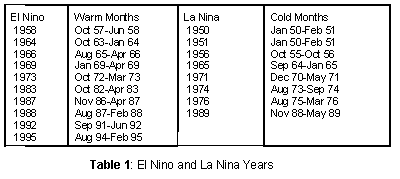
Norman, OK 73069
and Frank B. Tatom
Engineering Analysis Inc.
Huntsville, AL 35801
October 1999
1. INTRODUCTION
The presence of a warm/cold surface layer of water in the equatorial Pacific Ocean has been shown to be related to various climatological patterns around the world. As a whole, this phenomenon is called ENSO (El Nino/Southern Oscillation). The warm phase of the ENSO is known as El Nino phase, while the cold phase is called La Nina. This study explores the possible existence of a relationship between tornadic activity over portions of the United States and the ENSO phase.
2. DATA
The Storm Prediction Center's archive of United States tornadoes from 1950 through 1996 was used. Among the parameters in the data set includes the date and time of all reported tornadoes, the state, latitude, and longitude of each touchdown and lift-up, and the Fujita scale intensity rating (Schaefer et al. 1986).
The Climate Prediction Center's use of the mean sea surface temperature (SST) anomaly over the area extending from 5oN to 5oS and 180oW to 150oW is used for determination of an El Nino/La Nina. The criterion for an El Nino (warm episode) is an anomaly of at least 1oC, while for a La Nina (cold episode) the threshold was relaxed to 0.8oC (Livezey, 1998).
In this paper, an El Nino/La Nina year is one in which the temperature criterion over the key area was met for three or more consecutive months that included at least one Northern Hemisphere cold season month (December, January, February). These data were then compared to the tornado record for the year, or "tornado season" following the warm/cold event (Table 1).

For example, 1950 and 1951 tornadoes are both considered as La Nina related because of the cold SST anomaly that was present from January 1950 through February 1961. Similarly, the warm SST anomaly from January 1969 through April 1969 made all 1969 tornadoes El Nino affected.
3. UNITED STATES TORNADOES
As a preliminary study, a plot of all reported tornadoes over the contiguous United States as a function of the ENSO phase, was constructed (Fig. 1). Changes in tornado reporting efficiency since 1950 have caused an almost linear increase of nearly 15 reports a year. This dominates any ENSO effect.
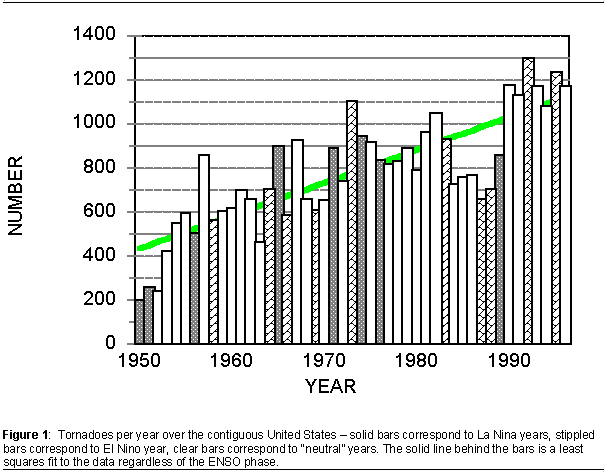
Before any comparisons can be made, this bias in the observations must be removed. While the number of tornadoes reported was greatest in 1992, the difference between the expected value (i.e., the least squares fit value) and the observed value was higher in 1973. In fact, using the delta as the standard of comparison drops the rank of 1992 to fifth. The average rank in terms of the delta in tornado count for the 10 El Nino years was 24.6. This compares to an average rank of 24.0 for the 8 La Nina years, and 23.7 for the 29 neutral years.
The Kruskal-Wallis H test (Walpole and Meyers, 1985) provides a means to determine if the difference in the average ranks of three or more independent samples is significant. Essentially this test tells if one can safely reject the hypothesis that all the samples came from the same parent population. Applying this test to the data shows that at the 5% significance level there is no reason to reject the hypothesis that the number of tornadoes reported across the contiguous United States in a given year is independent of the ENSO phase.
4. TORNADO ALLEY
From meteorological considerations, it is more realistic to expect that ENSO effects on tornado occurrence would be localized to quasi-homogeneous regions. To test this, tornado data from eight states lying between the Mississippi River and the high plains (Texas, Oklahoma, Kansas, Nebraska, Iowa, Missouri, Arkansas, Louisiana) were analyzed separately. This region essentially contains the proverbial "tornado alley" where tornadoes are most prevalent.
When the "all tornado" data (Fig. 2a) is considered, both the most tornadoes, and the largest deviation from the linear trend occurred in 1982 (a neutral year). Two El Nino years (1987, 1988) exhibited the largest negative deviations from the expected value, but fourth highest positive deviation also occurred during the warm phase (1973). The average ranking for El Nino years is 24.5, for La Nina years it is 29.25, and for neutral years it is 22.3. The Kruskal-Wallis H test shows that the differences between the ranking for the three ENSO phases have no significance at the 5% level.
When only F2 or greater tornadoes are considered (Fig. 2b), the first thing that is noted is that while there is still a quasi-linear trend with time in the data the slope of least squares fit line is negative. On the average, about one less strong or violent tornado is reported each year. This bias probably arises from better data collection methods. Before about 1978 virtually all F-scale determinations were made by college students reading newspapers from state archives, in the 1990's trained NWS Warning Coordination Meteorologists do most of the rating.
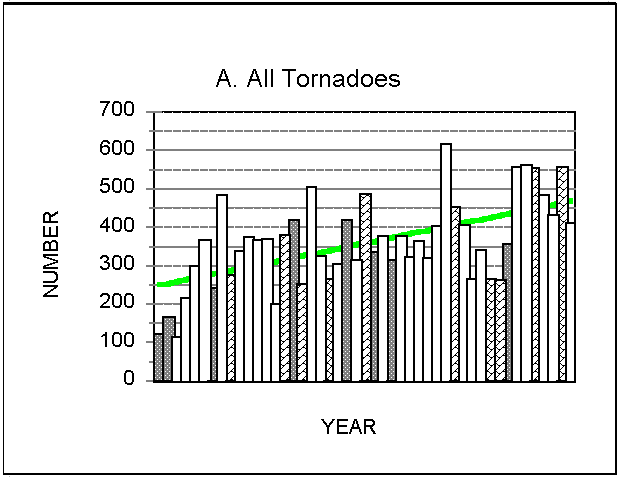
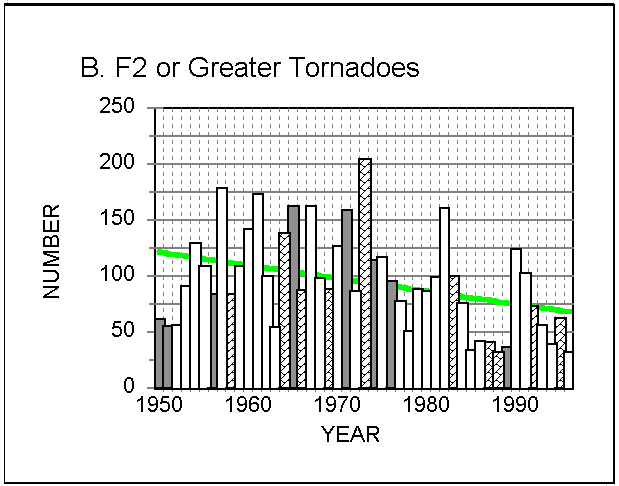
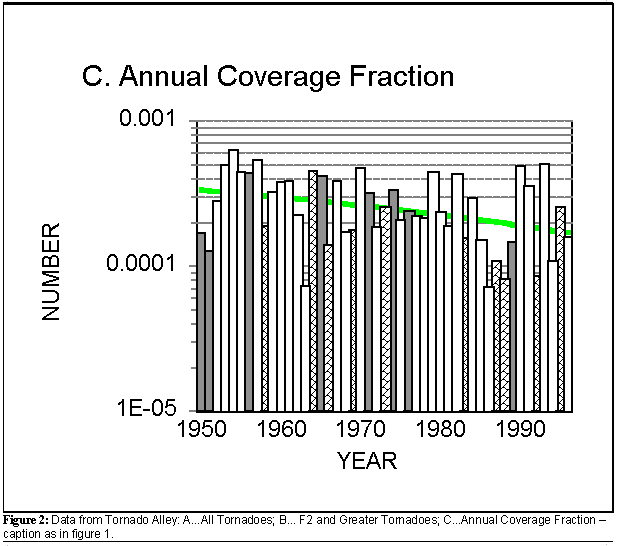
An El Nino year, 1973, had the most activity and the largest delta. This compares to its fourth place ranking when all tornadoes were considered. While two La Nina years had large positive deltas, three had large negative ones. The average rank for the ENSO phases were all within two positions and again they were statistically indistinguishable from each other.
The annual coverage fraction (ACF) is the fraction of the area within the region disturbed by tornadoes each year. It is the summed area of the individual tornadoes damage tracks, normalized by the size of the region. This parameter accounts for biases in tornado counts which arise when members of a family of tornadoes are reported as a single long track tornado (Doswell and Burgess, 1988). The ACF was calculated by means of the Site Assessment of Tornado Threat (SATT) software developed by Engineering Analysis Inc.
In the plot of Tornado Alley ACF as a function of ENSO phase (Fig. 2c, above), the five highest delta rankings were all neutral years. The mean ranking for the neutral years is 20.5, while it is 25.8 for La Nina years, and 32.6 for El Nino years. This difference is not significant at the 5% significance level, but it is at the 10% level. Based on the ACF, one could make a weak argument that both El Nino and La Nina conditions tend to suppress tornado activity over "tornado alley."
5. MIDEASTERN UNITED STATES
The United States, between the Mississippi River and the Appalachians was the location of the super tornado outbreak of April 3 - 4, 1974 (a La Nina year). To contrast this area from our previously defined tornado alley, a broad 9 state area (Mississippi, Alabama, Georgia, South Carolina, North Carolina, Tennessee, Kentucky, Indiana, Michigan) is used.
If the count of tornadoes is considered (Fig. 3A), the two biggest tornado years over this area (both in raw count and in difference from expected) were an El Nino year (1973) and a La Nina year (1974). The average ranking for La Nina years was 18.6, for El Nino years it was 23.6, and for neutral years it was 26.6. These differences are not statistically significant at the 10% level, much less the 5% level.
When only F2 and greater tornadoes over this area are considered, the number one and two years for all tornadoes change position. Now the La Nina year (1974) reported the most storms while the El Nino year came in second. While the eye is drawn to the 1965, 1974, and 1976 La Nina years on the bar graph (Fig. 3B), the lack of strong storms in 1950 and 1951 is just as notable. Over the 47 years of this study, the La Nina, neutral, and El Nino years had average rankings of 17, 25.2, and 26.1 respectively. These differences are statistically insignificant.
In the ACF analysis (Fig. 3C), the cold (1974), neutral (1994), and warm (1992) phases of the ENSO ranked first through third. The La Nina years did have the highest average rank (17.2), with the neutral years having the lowest average rank (25.5). However, again these differences are not statistically significant at even the 10% level.
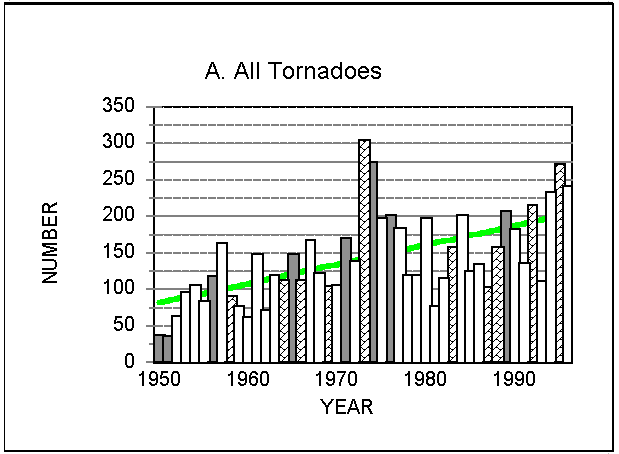
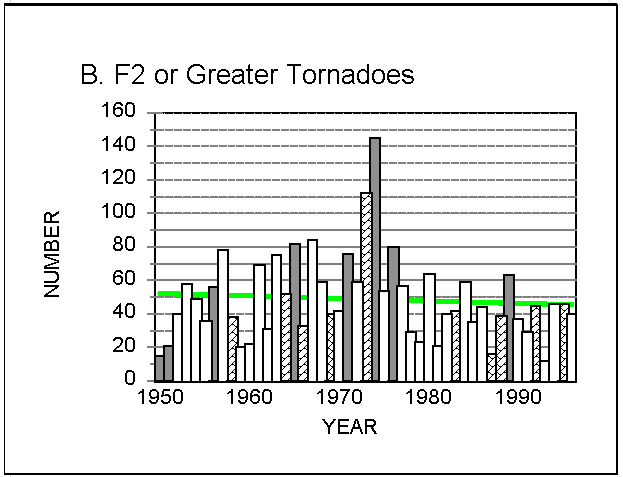
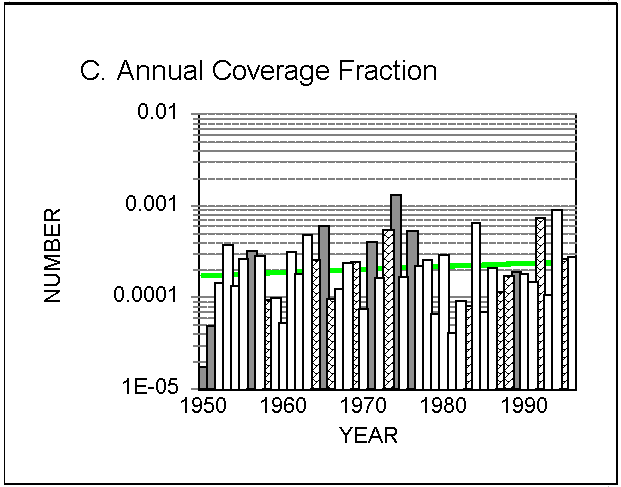
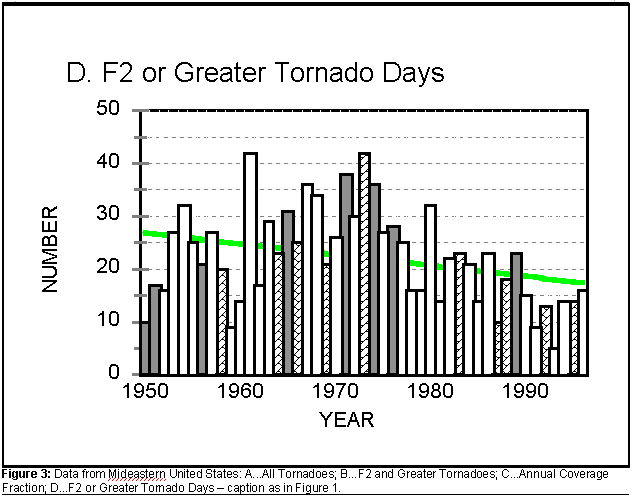
Tornado days (i.e., calendar days on which one or more tornadoes occur) are often used to filter out the domination of tornado outbreaks on the statistics. The idea is that the number of days when meteorological processes combine to create conditions favorable to tornado development, rather than a simple count of tornadoes, is really the significant factor. Over the Mideastern United States conditions supportive of strong and violent tornado occurred most often during the El Nino year of 1973 (Fig. 3D, above). As with the F2 tornadoes itself, the La Nina years in the 1970's that produced many storm days were offset by the La Nina years in the 1950's that had few storm days. The average rankings of 20.1 (La Nina), 24.4 (neutral) and 25.9 (El Nino) are not different statistically.
6. FLORIDA
Florida is positioned so the winter subtropical jet stream often bisects the state. This sets up conditions favorable for strong tornado development. All the statistical analyses performed for the other portions of the country were done for Florida. They showed no ENSO relationship at the 5% significance level. But, rankings for both the ACF and the number of F2 and greater tornadoes show differences at the 10% level. Strong and violent tornadoes (Fig. 4) were most frequent in 1972 (a neutral year), but the year with the most tornadoes was 1972. While eight of those storms were associated with Hurricane Agnes on June 18 and 19, there were 24 other such storms that year. The El Nino year of 1983 ranked second with 20 storms, and the La Nina year of 1971 ranked third with 18 storms.
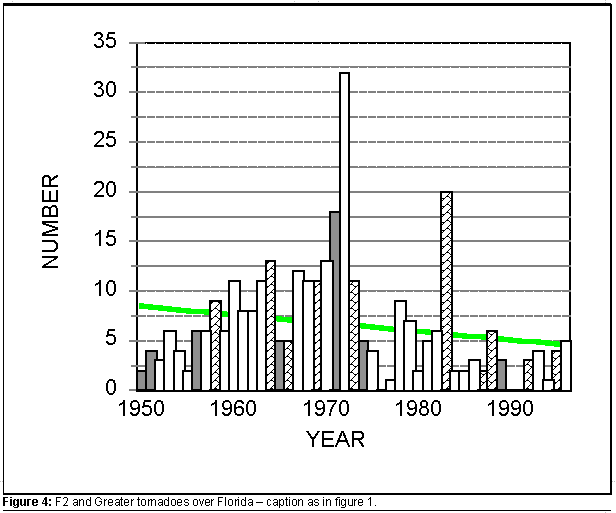
The average ranks for F2 and greater tornadoes in Florida are 30.6, 25, and 15.8 La Nina, neutral, and El Nino years respectively. The lack of strong tornadoes in the El Nino years of 1988, 1992, and 1995 keeps Florida F2 and greater tornadoes from having a dependence on El Nino that is significant at the 5% level. While in some years El Nino might set the stage for more strong and violent tornadoes than normal, the relationship is not strong enough to say that an El Nino will bring more strong tornado activity than normal to Florida.
7. MONTHLY COMPARISONS AND CONCLUSIONS
None of the statistical comparisons that we presented allow us to differentiate tornado activity as a function of the ENSO phase. There are some indications of a weak signal with F2 and greater tornadoes over Florida and with the ACF over tornado alley. Perhaps if one subdivided either the time window, or the areas considered some statistically significant correlations might be obtained. However, with only 10 El Ninos and 8 La Ninas over the 47 years of this study, the data is rather sparse. Tornadoes are even rarer. If the regions of study become too small, the validity of the study would be dubious no matter how great the statistical significance.
Since the Pacific sea surface temperature impacts other parts of the world through teleconnections, it is possible that there would be little or no lag between the occurrence of the warm/cold Pacific water and the associated weather. To examine this possibility, monthly values of various tornado parameters over the four areas presented in this paper were compiled. By assuming that tornado activity in A given month is independent of that in months, the 47-year time series from each month can be detrended with a least squares fit. Plots in the form of bar graphs with superposed best fit curve were created. Several will be presented at the conference, but there simply is not enough room to show one in this preprint.
The differences from each of the 564 months (72 El Nino, 67 La Nina, and 425 neutral) were ranked and tested with the Kruskal-Wallis H test to see if the hypothesis that all three samples came from the same population could be rejected. For Florida tornadoes, (both all tornadoes and F2 and greater tornadoes) there is no statistical basis to reject the single population hypothesis. However, significant differences as a function of ENSO phase were found in both the number of tornadoes and the number of strong and violent tornadoes for the Mideastern States, and for F2 and greater tornadoes over the entire contiguous United States. In these cases, more tornadoes appear to occur during La Nina months.
These findings are still tenuous. The validity of the method of detrending the data, and the assumption that consecutive months are independent of each other have to be evaluated. Also, meteorology has to be incorporated into the study to insure that any relation is not a statistical aberration.
Finally, it is necessary to examine if any findings have validity in a forecast sense. Even though the preliminary monthly correlations indicate a possible relationship between enhanced tornado activity over the mideastern states, the preliminary tornado data for 1998 vividly illustrate that long term statistical relationships do not necessarily make good long range forecast tools.
Acknowledgements: We would like to thank Dr. Robert Livezy of the NWS Climate Prediction Center for his help in getting the historical sea surface temperature data, and for his suggestion that monthly as well as annual relationships should be examined. Richard Sharp and Juli Cleland of EAI computed the ACF values using the SATT software, and Jason Trent of the SPC helped generate the graphics.
6. REFERENCES
Doswell, C.A. III, and D.W. Burgess, 1988: Some issues of United States tornado climatology, Mon. Wea. Rev., 116, 495-501.
Livezy, R.E., 1998: Personal Communication.
Schaefer, J.T, D.K. Kelly, and R.F. Abbey, 1986: A minimum assumption tornado-hazard probability model. J. Climate and Appl. Meteor., 12, 1934-1945.
Walpole, R.E., and R.H.Meyers, 1985: Probability and Statistics for Engineers and Scientists, Third Edition. MacMillan Publishing Co., New York, 544-546.